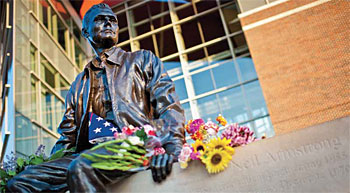Saluting a quiet hero
Armstrong died Aug. 25 following complications from heart surgery. He was 82.
Millions of people around the world still remember July 20, 1969, at 8:17 p.m. Coordinated Universal Time (UTC) when they were transfixed on the flickering black-and-white video images showing Armstrong descending a ladder from the Lunar Module (LM).

When Armstrong uttered the words, “Houston, Tranquility Base here. The Eagle has landed,” a collective sigh of relief had filled the air. As he touched the lunar surface, Armstrong uttered this famous phrase: “One small step for [a] man, one giant leap for mankind.”
In his authorized biography, “First Man: The Life of Neil A. Armstrong,” Armstrong revealed to his biographer James R. Hansen the personal memorabilia he took with him to the moon: some jewelry for his wife and mother, an old fraternity pin from Purdue and some Apollo 11 medallions. According to the book, however, Armstrong was most proud of safely transporting a piece of the historic Wright Brothers Flyer to and from the moon.
Aviation in his blood

When Armstrong was born on Aug. 5, 1930, in Wapakoneta, Ohio, aviation was still young. Charles Lindbergh had flown solo across the Atlantic Ocean to Paris just three years earlier.
From a very early age, Armstrong — a future U.S. Navy test pilot, aerospace engineer, and NASA astronaut — was fascinated with aviation. He earned his pilot’s license as a teenager and idolized Lindbergh.
After his service in the Korean War, Armstrong took part in the fledgling Boeing X-20 Dyna-Soar human spaceflight program. He joined the NASA Astronaut Corps in 1962.
His first spaceflight was the NASA Gemini 8 mission in 1966, for which he was the command pilot. He performed the first manned docking of two spacecraft with pilot David Scott, preparing for what may be the greatest accomplishment in human history.
"It's different, but it's very pretty out here. I suppose they are going to make a big deal of all this."
– Neil A. Armstrong
Armstrong’s second and final spaceflight was as mission commander of the Apollo 11 moon landing in July 1969. On that mission, Armstrong and Buzz Aldrin descended to the lunar surface in the Lunar Module and spent 2-1/2 hours exploring, while Michael Collins remained in orbit in the Command Module.
He epitomized the calm, confident tone astronauts respected. In reporting from the moon, he matter-of-factly told controllers, “It’s different, but it’s very pretty out here. I suppose they are going to make a big deal of all this.”
Remembering a humble hero

More than 1,000 people gathered near Armstrong’s statue at Neil Armstrong Hall of Engineering for a memorial service on Aug. 27.
Joe Rust, president of Purdue Student Government, which organized the service, told the crowd that the astronaut “inspired us to go beyond the classroom, beyond our boundaries and even challenged us to go beyond Earth.”
Tim Sands, acting president, says Armstrong is likely the most famous and inspirational alumnus of Purdue, and was an integral part of campus life from his arrival as a young student in the ’50s until his death.
“He was a humble and private person, but always willing to talk to students,” Sands says. “He was passionate about encouraging young men and women to pursue careers in science and engineering.”
Leah Jamieson, the John A. Edwardson Dean of Engineering, echoes Sands’ remarks, saying, “He inspired us all. He would say that engineering is about ‘what can be’ and gave us unforgettable images of just how bold and inspiring the future can be. He was proud of being an engineer, and we have always been enormously proud that he was a Purdue engineer.”
President Emeritus France A. Córdova, a former NASA scientist, speaks for many when she recalls the excitement of Apollo 11 heading for the moon with the goal to put two men on its surface.
“Everyone was watching Neil Armstrong take humankind’s first step on the moon,” she says. “Grainy as black-and-white TV was at the time, you knew it was the real thing. It changed lives, career paths, dreams. For me it was a turning point.”

She finally was able to meet Armstrong in person at the opening of Neil Armstrong Hall in October 2008. “He was humble — giving credit to the engineers who put him on the moon,” Córdova says.
NASA astronaut Scott Tingle (MSME ’88) was 4 years old when Armstrong left his footprint on the moon’s surface. Tingle says Armstrong carried “the hopes and dreams of not only one man, one crew or a single country, but of the human race.”
“While we have learned about explorers such as Magellan, Columbus, Lewis and Clark, the legend of Neil Armstrong and Apollo 11’s epic journey to the moon will forever take center stage in our history lessons.”
Retired astronaut Gene Cernan (BSEE ’56), the last man to leave his footprint on the moon, remembers his friend as “all that is good and great about this nation,” he says. “To Neil it was never about him, it was always about those who a generation and a half ago made it all possible. He truly was a reluctant hero.”
